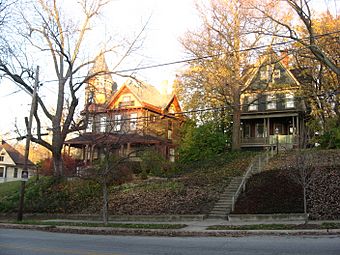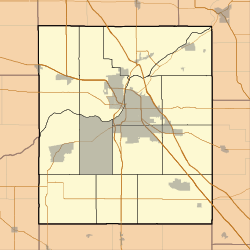Ninth Street Hill Neighborhood Historic District facts for kids
Quick facts for kids |
|
|
Ninth Street Hill Neighborhood Historic District
|
|

Ninth Street Hill, November 2009
|
|
| Location | Roughly, 9th St. from South to Kossuth Sts. and State St. from 9th to Kossuth Sts., Lafayette, Indiana |
|---|---|
| Area | 30 acres (12 ha) |
| Architect | Thise, Lawrence & James R.; Halstead, George |
| Architectural style | Gothic Revival, Italianate, Queen Anne |
| NRHP reference No. | 97000303 |
| Added to NRHP | April 14, 1997 |
The Ninth Street Hill Neighborhood Historic District is a special area in Lafayette, Indiana. It's like a protected neighborhood where many old and important buildings are kept safe. This district is located in Tippecanoe County, Indiana. It was officially recognized as a national historic district because of its unique history and architecture.
This historic area covers about 30 acres. It includes 88 important buildings and 6 other structures that help tell the story of the neighborhood. Most of these are homes. The district grew between the 1850s and 1946. It shows off many different building styles from that time.
Contents
Exploring the Historic Ninth Street Hill
The Ninth Street Hill area is a great place to see how buildings used to look. It's like a living museum of architecture. People who live here work to keep the old charm alive. This helps everyone understand the past better.
Architectural Styles You Can See
The buildings in this district show several cool architectural styles. Each style has its own special look.
Gothic Revival Buildings
Some homes here are built in the Gothic Revival style. This style became popular in the mid-1800s. It often features pointed arches and steep roofs. These details make buildings look a bit like old castles or churches.
Italianate Style Homes
You'll also find many Italianate style houses. This style was popular around the same time. Italianate homes often have low-pitched roofs and wide eaves. They also have tall, narrow windows and decorative brackets under the roof.
Queen Anne Architecture
The Queen Anne style is another common one. These homes are usually very colorful and have lots of different textures. They often feature turrets, towers, and decorative porches. They look very grand and detailed.
Greek Revival and Second Empire Styles
A few buildings also show Greek Revival and Second Empire styles. Greek Revival buildings often have columns and look like ancient Greek temples. Second Empire buildings usually have a special type of roof called a mansard roof. This roof has slopes on all four sides.
Famous Homes in the District
Many important houses are part of the Ninth Street Hill Historic District. Each one has its own story.
The Judge Cyrus Ball House
One very important home is the Judge Cyrus Ball House. It's so special that it's listed separately on the National Register of Historic Places. This means it's recognized for its own unique history.
Other Notable Houses
Other interesting homes include the Samuel Moore House, built in 1891. There's also the Moore-Porter-Boswell House from 1895. The Stanley Coulter House (1890) and the Edward Bohrer House (1909) are also here. You can also see the Thomas Wood House (around 1850) and the Job M. Nash House (1859). The Gordon Graham House (around 1900) is another example of the district's rich history.
Protecting History: National Register of Historic Places
The Ninth Street Hill Neighborhood Historic District was added to the National Register of Historic Places in 1997. This is a list kept by the United States government. It includes places that are important to American history, architecture, or culture. Being on this list helps protect these places. It also encourages people to learn about and preserve them for the future.




